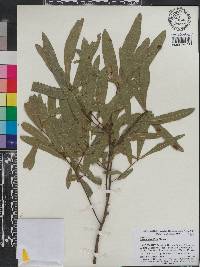|
|
|
|
Family: Fagaceae
laurel oak
[Quercus obtusa (Willd.) Ashe, moreQuercus phellos var. laurifolia (Michx.) Chapm., Quercus succulenta Small] |
Trees , tardily deciduous, to 40 m. Bark dark brown to black, ridges flat, furrows deep. Twigs red-brown, (1-)1.5-2.5 mm diam., glabrous. Terminal buds dark red-brown, ovoid to subconic, 2.5-6 mm, distinctly 5-angled in cross section, glabrous or with tuft of reddish hairs at apex. Leaves: petiole 1.5-5 mm, glabrous. Leaf blade rhombic or broadly elliptic to obovate, occasionally oblong or spatulate, 30-120 × 15-45 mm, thin, base attenuate or cuneate, rarely obtuse, margins entire with 1 apical awn, apex obtuse or rounded; surfaces abaxially glabrous, adaxially glabrous, veins raised. Acorns biennial; cup shallowly saucer-shaped to deeply bowl-shaped, 3.5-9 mm high × 11-17 mm wide, covering 1/4-1/2 nut, outer surface puberulent, inner surface pubescent at least 1/2 distance to rim, scale tips appressed, acute or attenuate; nut globose or ovoid, 8.5-16 × 10-16 mm, glabrate, scar diam. 6.5-11.5 mm. Flowering spring. Sandy flood plains and bottoms, riverbanks, and terraces, occasionally on poorly drained uplands; 0-150 m; Ala., Ark., Fla., Ga., La., Miss., N.C., S.C., Tex., Va. Quercus laurifolia apparently flowers two weeks earlier than sympatric Quercus hemisphaerica (W. H. Duncan and M. B. Duncan 1988). It reportedly hybridizes with Q . falcata , Q . incana , and Q . nigra (H. A. Fowells 1965); with Q . hemisphaerica , Q . marilandica , Q . myrtifolia , Q . phellos , and Q . shumardii (D. M. Hunt 1989); and with Q . velutina .
Tree to 25 m; twigs glabrous; reddish-tinted; lvs usually yellowish or green when young, only seldom bronzy-red at maturity, coriaceous, glossy beneath, narrowly oblong to lanceolate, elliptic, rhombic, or narrowly obovate, typically 5.5-9 נ1.5-3 cm, rounded-obtuse at the tip, tapering to a narrow, acute base, consistently entire, essentially glabrous except usually for some persistent tomentum in the vein-axils beneath, obscurely reticulate or with the reticulum more prominent on the lower surface than the upper, subpersistent, but turning brown in the fall and deciduous before spring; petiole 2-5 mm; acorns 1.5 cm, the cup depressed-hemispheric. Moist or wet soil, chiefly on the coastal plain; se. Va. to Fla., s. Ark., and e. Tex. (Q. obtusa) Gleason, Henry A. & Cronquist, Arthur J. 1991. Manual of vascular plants of northeastern United States and adjacent Canada. lxxv + 910 pp. ©The New York Botanical Garden. All rights reserved. Used by permission. |




